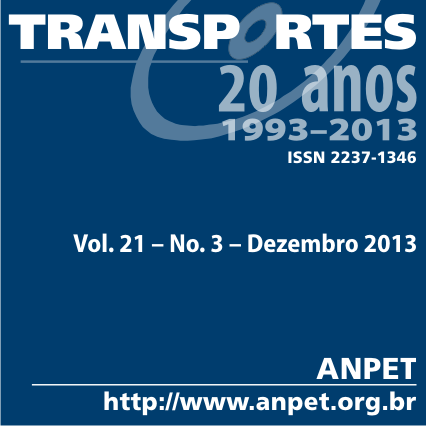MÉTODO PROBABILÍSTICO PARA IDENTIFICAÇÃO DE ZONAS DE ACUMULAÇÃO DE ACIDENTES
DOI:
https://doi.org/10.4237/transportes.v21i3.683Resumo
Neste trabalho apresenta-se um novo método de definição e identificação de zonas de acumulação (ZAA) de acidentes considerando um modelo de regressão binário. Este modelo permite calcular a probabilidade de um local ser ou não ZAA tendo em conta as características geométricas e funcionais do mesmo. Este novo método foi aplicado ao caso das interseções tendo-se, para tal, gerado uma base de dados fictícia considerando as características da sinistralidade e das interseções da cidade do Porto. Através da simulação de dados é possível conhecer a priori as “verdadeiras” ZAA. O desempenho do método foi analisado com base nos erros resultantes da classificação dos locais em ZAA ou não-ZAA, e comparado com dois dos métodos mais aplicados e analisados – o método de ranking pelo número de acidentes e o método Bayesiano-empírico. Desta análise verificou-se que o método binário proposto tem claramente melhor desempenho.
Downloads
Referências
AASHTO (2010) Highway Safety Manual. American Association of State Highway and Transportation Officials, Washington DC.
ISBN: 978-1-56051-477-0
Cafiso, S. e Silvestro, G. D. (2011) Performance of Safety Indicators in Identification of Black Spots on Two-Lane Rural Roads Transportation Research Record: Journal of the Transportation Research Board, 2237, 78-87.
DOI: 10.3141/2237-09
Cardoso, J. L. (1998) Definição e detecção de zonas de acumulação de acidentes. Segurança Rodoviária - Avaliação e Redução da Sinistralidade, LNEC, Lisboa, 131-133.
Carlin, B. e Louis, T. (2000) Bayes and Empirical Bayes Methods for Data Analysis. Chapman and Hall, London.
ISBN: 1439840954
Cheng, W. e Washington, S. (2008) New Criteria for Evaluating Methods of Identifying Hot Spots. Transportation Research Record: Journal of the Transportation Research Board, 2083, 76-85.
DOI: 10.3141/2083-09
Cheng, W. e Washington, S. P. (2005) Experimental evaluation of hotspot identification methods. Accident Analysis & Prevention, 37, 870-881.
DOI: 10.1016/j.aap.2005.04.015
Elvik, R. (2008) Comparative Analysis of Techniques for Identifying Locations of Hazardous Roads. Transportation Research Record: Journal of the Transportation Research Board, 2083, 72-75.
DOI: 10.3141/2083-08
Ferreira, S. (2010) A Segurança Rodoviária no processo de planeamento de redes de transportes. Ph.D. dissertation, University of Porto.
Fridstrom, L., Ifver, J., Ingebrigtsen, S., Kulmala, R. e Thomsen, L. K. (1995) Measuring the contribution of randomness, exposure, weather and dayligth to the variation in road accident counts. Accident Analysis and Prevention, 27, 1-20.
DOI: 10.1016/0001-4575(94)E0023-E
Geedipally, S. R. e Lord, D. (2010) Identifying Hot Spots by Modeling Single-Vehicle and Multivehicle Crashes Separately Transportation Research Record: Journal of the Transportation Research Board, 2147, 97-104.
DOI: 10.3141/2147-12
Greene, W. H. (2008) Econometric Analysis. Sixth Edition. Pearson International Edition, New Jersey.
ISBN-13:978-0-13-513740-6; ISBN-10:0-13-513740-3
Greibe, P. (2003) Accident prediction models for urban roads. Accident Analysis and Prevention, 35, 273-285. DOI: 10.1016/S0001-4575(02)00005-2
Huang, H. e Haque, H. C. C. M. M. (2009) Empirical Evaluation of Alternative Approaches in Identifying Crash Hot Spots. Naive Ranking, Empirical Bayes, and Full Bayes Methods. Transportation Research Record: Journal of the Transportation Research Board, 2103, 32-41.
DOI: 10.3141/2103-05
Lan, B. e Persaud, B. (2011) Fully Bayesian Approach to Investigate and Evaluate Ranking Criteria for BlackSpot Identification. Transportation Research Record: Journal of the Transportation Research Board, 2237, 117-125.
DOI: 10.3141/2237-13
Lord, D. (2000) The prediction of accidents on digital networks: characteristics and issues related to the application of accident prediction models. Ph.D. dissertation, University of Toronto. http://hdl.handle.net/1807/14514
Lord, D. (2006) Modeling motor vehicle crashes using Poisson-gamma models: examining the effects of low sample mean values and small sample size on the estimation of the fixed dispersion parameter. Accident Analysis and Prevention, 38, 751-766.
DOI: 10.1016/j.aap.2006.02.001
Lord, D. e Persaud, B. N. (2004) Estimating the safety performance of urban road transportation networks. Accident Analysis and Prevention, 36, 609-620.
DOI: 10.1016/S0001-4575(03)00069-1
Miranda-Moreno, L. F., Fu, L., Saccomanno, F. F. e Labbe, A. (2005) Alternative Risk Models for Ranking Locations for Safety Improvement. Transportation Research Record: Journal of the Transportation Research Board, 1908, 1-8.
DOI: 10.3141/1908-01
Montella, A. (2010) A comparative analysis of hotspot identification methods. Accident Analysis and Prevention, 42, 571-581.
DOI: 10.1016/j.aap.2009.09.025
OCDE (1997) Road safety principles and models: review of descriptive, predictive, risk and accident consequence models.Organisation for Economic Co-operation and Development, Paris. http://www.oecd.org/sti/transport/roadtransportresearch/2103285.pdf
Schluter, P. J., Deely, J. J. e Nicholson, A. J. (1997) Ranking and selecting motor vehicle accident sites by using a hierarchical Bayesian model. The Statistician, 46, 293-316.
DOI: 10.1111/1467-9884.00084
Downloads
Publicado
Como Citar
Edição
Seção
Licença
Ao submeter um manuscrito para publicação neste periódico, todos os seus autores concordam, antecipada e irrestritamente, com os seguintes termos:
- Os autores mantém os direitos autorais e concedem à Transportes o direito de primeira publicação do manuscrito, sem nenhum ônus financeiro, e abrem mão de qualquer outra remuneração pela sua publicação pela ANPET.
- Ao ser publicado pela Transportes, o manuscrito fica automaticamente licenciado sob a Licença Creative Commons CC BY 4.0. Esta licença permite o seu compartilhamento com reconhecimento da autoria e da publicação inicial neste periódico.
- Os autores têm autorização para assumir contratos adicionais separadamente, para distribuição não exclusiva da versão do trabalho publicada neste periódico (por ex.: publicar em repositório institucional ou como capítulo de livro), com reconhecimento da publicação inicial na Transportes, desde que tal contrato não implique num endosso do conteúdo do manuscrito ou do novo veículo pela ANPET.
- Os autores têm permissão e são estimulados a publicar e distribuir seu manuscrito online (por ex.: em repositórios institucionais ou na sua página pessoal) depois de concluído o processo editorial. Como a Transportes é de acesso livre, os autores são estimulados a usar links para o DOI do artigo nesses casos.
- Os autores garantem que obtiveram todas as permissões necessárias dos empregadores para a publicação e o licenciamento CC BY 4.0 do manuscrito, especialmente se o empregador possuir alguma reivindicação sobre os direitos autorais do manuscrito. Os autores assumem total responsabilidade por questões de direitos autorais relacionadas ao empregador, isentando a ANPET e a Transportes de qualquer responsabilidade relacionada.
- Os autores assumem toda responsabilidade sobre o conteúdo do manuscrito, incluindo as devidas e necessárias autorizações para divulgação de dados coletados e resultados obtidos, isentando a ANPET e a Transportes de toda e qualquer responsabilidade neste sentido.
Última atualização: 27/11/2025











